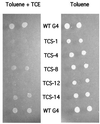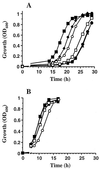Requirement of DNA repair mechanisms for survival of Burkholderia cepacia G4 upon degradation of trichloroethylene
- PMID: 11722883
- PMCID: PMC93320
- DOI: 10.1128/AEM.67.12.5384-5391.2001
Requirement of DNA repair mechanisms for survival of Burkholderia cepacia G4 upon degradation of trichloroethylene
Abstract
A Tn5-based mutagenesis strategy was used to generate a collection of trichloroethylene (TCE)-sensitive (TCS) mutants in order to identify repair systems or protective mechanisms that shield Burkholderia cepacia G4 from the toxic effects associated with TCE oxidation. Single Tn5 insertion sites were mapped within open reading frames putatively encoding enzymes involved in DNA repair (UvrB, RuvB, RecA, and RecG) in 7 of the 11 TCS strains obtained (4 of the TCS strains had a single Tn5 insertion within a uvrB homolog). The data revealed that the uvrB-disrupted strains were exceptionally susceptible to killing by TCE oxidation, followed by the recA strain, while the ruvB and recG strains were just slightly more sensitive to TCE than the wild type. The uvrB and recA strains were also extremely sensitive to UV light and, to a lesser extent, to exposure to mitomycin C and H(2)O(2). The data from this study establishes that there is a link between DNA repair and the ability of B. cepacia G4 cells to survive following TCE transformation. A possible role for nucleotide excision repair and recombination repair activities in TCE-damaged cells is discussed.
Figures




Similar articles
-
Selection of a Pseudomonas cepacia strain constitutive for the degradation of trichloroethylene.Appl Environ Microbiol. 1992 Dec;58(12):3977-83. doi: 10.1128/aem.58.12.3977-3983.1992. Appl Environ Microbiol. 1992. PMID: 1282314 Free PMC article.
-
Cytotoxicity associated with trichloroethylene oxidation in Burkholderia cepacia G4.Appl Environ Microbiol. 2001 May;67(5):2107-15. doi: 10.1128/AEM.67.5.2107-2115.2001. Appl Environ Microbiol. 2001. PMID: 11319088 Free PMC article.
-
Enhancing trichloroethylene degradation using non-aromatic compounds as growth substrates.J Hazard Mater. 2014 Jun 30;275:99-106. doi: 10.1016/j.jhazmat.2014.04.052. Epub 2014 Apr 30. J Hazard Mater. 2014. PMID: 24857894
-
Degradation of trichloroethylene by Pseudomonas cepacia G4 and the constitutive mutant strain G4 5223 PR1 in aquifer microcosms.Appl Environ Microbiol. 1993 Aug;59(8):2746-9. doi: 10.1128/aem.59.8.2746-2749.1993. Appl Environ Microbiol. 1993. PMID: 7690223 Free PMC article.
-
Genetic toxicology of trichloroethylene (TCE).Mutat Res. 1995 Nov;340(1):1-36. doi: 10.1016/0165-1110(95)90002-0. Mutat Res. 1995. PMID: 8524349 Review. No abstract available.
Cited by
-
Acinetobacter baumannii RecA protein in repair of DNA damage, antimicrobial resistance, general stress response, and virulence.J Bacteriol. 2011 Aug;193(15):3740-7. doi: 10.1128/JB.00389-11. Epub 2011 Jun 3. J Bacteriol. 2011. PMID: 21642465 Free PMC article.
-
The Effects of Freeze-Thaw and UVC Radiation on Microbial Survivability in a Selected Mars-like Environment.Microorganisms. 2022 Mar 7;10(3):576. doi: 10.3390/microorganisms10030576. Microorganisms. 2022. PMID: 35336151 Free PMC article.
-
Characterization of the adaptive response to trichloroethylene-mediated stresses in Ralstonia pickettii PKO1.Appl Environ Microbiol. 2002 Nov;68(11):5231-40. doi: 10.1128/AEM.68.11.5231-5240.2002. Appl Environ Microbiol. 2002. PMID: 12406709 Free PMC article.
-
Acetylene Tunes Microbial Growth During Aerobic Cometabolism of Trichloroethene.Environ Sci Technol. 2024 Apr 9;58(14):6274-6283. doi: 10.1021/acs.est.3c08068. Epub 2024 Mar 26. Environ Sci Technol. 2024. PMID: 38531380 Free PMC article.
-
Addition of aromatic substrates restores trichloroethylene degradation activity in Pseudomonas putida F1.Appl Environ Microbiol. 2004 May;70(5):2830-5. doi: 10.1128/AEM.70.5.2830-2835.2004. Appl Environ Microbiol. 2004. PMID: 15128539 Free PMC article.
References
-
- Arp D J. Understanding the diversity of trichloroethylene co-oxidations. Curr Opin Biotechnol. 1995;6:352–358.
-
- Banerjee S, Van Duuren B L. Covalent binding of the carcinogen trichloroethylene to hepatic microsomal proteins and to exogenous DNA in vitro. Cancer Res. 1978;38:776–780. - PubMed
-
- Bergman K. Interactions of trichloroethylene with DNA in vitro and with RNA and DNA of various mouse tissues in vivo. Arch Toxicol. 1983;54:181–193. - PubMed
-
- Demple B, Harrison L. Repair of oxidative damage to DNA: enzymology and biology. Annu Rev Biochem. 1994;63:915–948. - PubMed
Publication types
MeSH terms
Substances
Associated data
- Actions
- Actions
- Actions
- Actions
LinkOut - more resources
Full Text Sources

